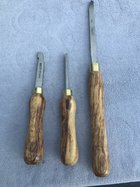I have a couple of thread chasers that I intend to make handles for. The tang is about 8-9mm wide and 5mm thick. My plan was to drill a 9mm hole in the handle and turn a 9mm diameter dowel. Split the dowel and sand it so that when placed either side of the tang, the result is more or less the size of the hole in the handle. Epoxy it in. Fit the ferrule. I appreciate I will need space to allow the epoxy to ooze out as it’s put together. Is there a better /simpler way?
The thread chasers don’t really require anything too robust but I planned on using the technique on a larger scraper.
The thread chasers don’t really require anything too robust but I planned on using the technique on a larger scraper.

